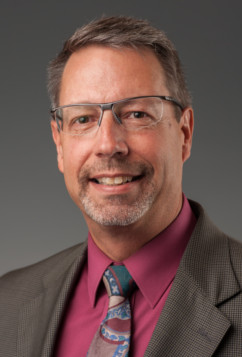1124 S. State Street
Big Rapids, Michigan
[email protected]
(231) 591-3700
Educating Students and Serving Patients
Update from David Durkee, OD, FAAO Assisatnt Dean for Clinical Affairs and Director of Externships

Conducting an educational clinical learning experience, by itself, is already a large task. With as many as 74 clinical students, 22 faculty, and 6,000 patients a year, the University Eye Center at the Michigan College of Optometry has many moving parts. The balance to achieve exemplary patient care while still educating optometry’s future requires a careful coordination of resources. It’s a delicate balance. Producing qualified graduates that can deliver high quality optometric care, pass board exams, meet accreditation standards, and satisfy patients’ needs while on a budget is the definition of living almost on the edge.
That careful balance was challenged mightily with the pandemic. How can we deliver
patient care and educate students when everything is shut down? In the early days
of the pandemic, the transmission and morbidity of the contagion were unknown. In
March of 2020, all clinic operations were halted while
examination and planning could occur. Meanwhile the clock was ticking on patient care
and student education. We immediately started examining our patient files for those
that needed urgent care, and created a schedule for emergency visits. All, of course,
after developing our infection control protocols. One early decision we had to make
was how safe were our protocols to be constructed. We decided that erring on the side
of a conservative approach to infection control was the best policy. My overall premise
was “assume everyone is already infected”, and we’ll still see patients while protecting
ourselves.
So for several months the clinic operated with volunteer faculty covering urgent care
issues. The 3rd year
students continued clinic sessions by participating in “virtual” clinics mostly over
ZOOM video meetings.
This was deemed adequate to send these students to off campus externships in June
as newly minted 4th
year students. But our rising 2nd year class lost some of their spring clinics, and
we deemed it too risky to
have all 36 students in their new 3rd year Summer clinic. This Class of 2022 would
then be without real
clinical experiences for nearly 4 months. Meanwhile, the campus clinic did operate
in the Summer with our
normal four 4th year students, plus 1 more 4th year displaced from a closed externship
location. Routine
and specialty care then continued at a lower volume, as we learned how to manage the
resources in the
clinic to control the infection. Largely, it worked!
This Fall, the lingering problem were those 3rd year students that needed to catch
up on clinical
experiences missed over the summer. We worked on creating extra “make-up” clinics
for 10 weeks to
account for the hours lost. This was possible with our existing resources as we paired
all the students in
primary care and make-up clinics, where normally the students would be working alone.
With additional
time slots made available by coordinating class/lab schedules, there was room in the
clinic operations to
accommodate all the moving parts. Although the system worked, and performed in a safe
manner, just
imagine the fall schedule of the typical 3rd year student. Half the class had 5 clinic
sessions per week, plus
the challenge of remote classes and normal labs. But I could not think of many groups
more prepared than
this Class of 2022. They were dedicated, intelligent, cooperative, and driven to excel.
They have handled
the enormous extra Fall workload with aplomb.
As we near the end of fall term, MCO’s clinic operations are about back on track,
and although our volumes
are still slightly reduced, the students are seeing a sufficient number and variety
of patients to meet the
program’s goals. Many thanks go to the students, faculty, staff, and administration
at MCO for meeting the
challenge head on with exemplary work and cooperation. It will be a time we will never
forget.

